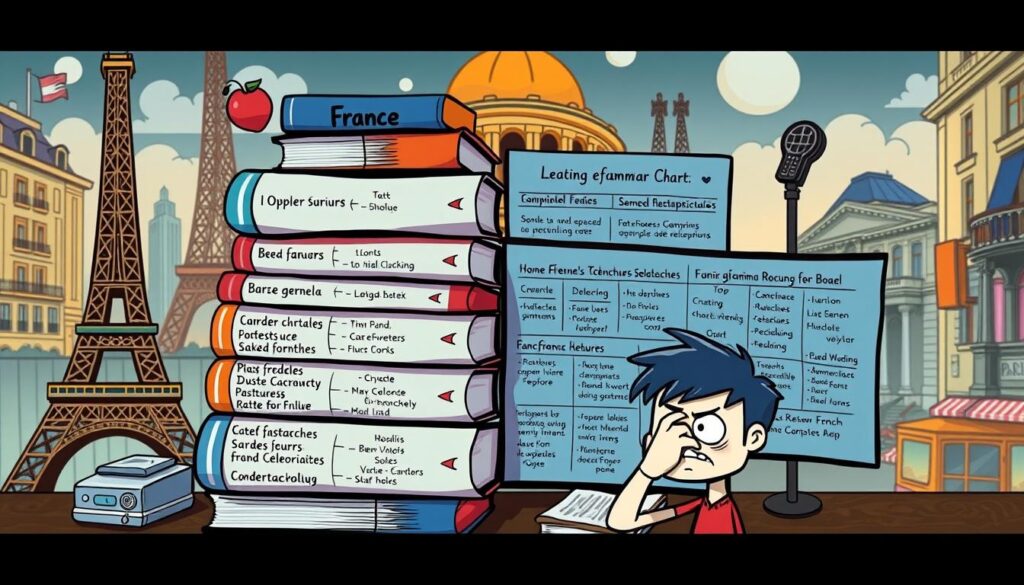Learning French can be exciting, especially when exploring through classes or self-learning resources. You’ll quickly find out how important articles are. Especially, knowing when to use le and de. These two small words make a big difference in speaking French correctly.
In French, articles like le, la, l’, and les are used 99 percent of the time, unlike in English. This fact makes it crucial to understand the difference between le and de. Le is used to point out specific things that are already known. Whereas de is used for indicating a part of something or an undefined quantity, often meaning “some” or “any”.
The challenge of choosing between le and de in French is common for students. There are rules on using l’ with nouns starting with a vowel or silent h. Also, knowing how to use partitive articles like du, de la, and des is key. Plus, there’s when to drop the article in certain expressions or with an aspirated h.
When using verbs expressing likes, such as ‘aimer’ or ‘préférer’, you use le, la, l’, or les. However, in negations, un, une, and des change to de or d’. The details of French articles affect how well you can speak and write. To get better, look at examples and practice their use often.
Introduction to French Articles: Le and De
When you start learning French, you quickly learn that using articles like le and de is important. They help you understand French grammar better. Knowing how to use le and de is key because it changes what you’re saying.
Defining the Articles in French Language
In French, there are four main articles: le, la, l’, and les. Each one has a special role. Le is used with masculine nouns to talk about something specific. For example, ‘le livre’ means ‘the book’ we both know. De, on the other hand, shows a quantity of something but not exact. Like ‘de l’eau’ means ‘some water,’ without saying how much.
The Role of Articles in French Grammar
The rules for le and de in French are important for being clear. Using le and de correctly helps make what you say specific. Le talks about known things, while de suggests a part or some of something. This makes your sentences full of meaning.
Here’s a table showing how to use le and de in French sentences. It points out their importance in speaking and writing clearly:
| Article | Example in French | Translation | Usage |
|---|---|---|---|
| Le | Le chat | The cat | Refers to a specific cat known to the speaker and listener |
| De | De l’énergie | Some energy | Indicates an unspecified amount or type |
| Le | Le bonheur | The happiness | Used for abstract concepts, definite |
| De | De l’eau | Some water | Partitive article indicating an undetermined quantity |
This guide shows you the difference between le and de. It can help you get better at French. By using these tips, you’ll understand how to improve your conversations and writing.
Distinguishing Partitive Articles from Definite Articles
Learning French means knowing how to use partitive and definite articles. This is vital for speaking the language well. Understanding the difference between them helps master French. Here’s a look at le vs de in French and their roles in making sentences.
Definite articles like “le,” “la,” “l’,” and “les” point to specific nouns both the speaker and listener know. They’re like “the” in English. Partitive articles, “du,” “de la,” “de l’,” and “des,” show a part of something. They often mean “some” or “any” in English, used with nouns where the amount isn’t known.
- Definite Article: “Le piano est vieux.” (The piano is old.) – It’s about a particular piano.
- Partitive Article: “Il veut de la glace.” (He wants some ice cream.) – It shows an unknown amount of ice cream.
In negative statements, partitive articles turn into “de” or “d'” to show absence. Like in “Je n’ai pas de stylo.” (I do not have a pen.) This rule is a must-know to avoid errors.
Using these articles correctly adds depth to conversation. For English speakers, understanding the difference between ‘some’ and ‘the’ is crucial. Practicing with le and de examples in French helps grasp their use.
Knowing how and when to use these articles is key in French. It makes speaking and understanding the language much easier and accurate.
Difference between Le and De in French
Knowing the difference between le and de in French can really boost how well you understand and speak the language. Let’s look closely at how these articles are used differently. This will help us get why they are so important.
Understanding Le for Definiteness
In French, ‘le’ is used to talk about specific things. It’s a key part of le and de french grammar. You use ‘le’ when you’re naming certain days, or when talking about ideas that are clear and definite.
Grasping De for Partiality
On the other hand, ‘de’ is used for partial things. It’s used to talk about amounts that aren’t exact. Knowing when to choose ‘de’ over ‘le’ is vital. It’s used a lot when you’re talking about food amounts or vague ideas.
Contextual Usage of Le and De in French
Understanding when to use le and de in the french language is all about context. For example, ‘le’ is often used before languages or sports names. ‘De’ might be used before a hobby or a time of day. This shows a level of specificity.
Exploring deeper into le and de usage in french, it’s clear that patterns emerge. These patterns depend on if the nouns are countable, specific, or owned by someone. Using ‘le’ and ‘de’ right can also add emotion or formality to your French.
| Article | Context | Examples |
|---|---|---|
| Le | Specific, definite nouns | Le chat (The cat), Le France (Regarding France) |
| De | Partitive, non-specific quantities | De l’eau (Some water), De la musique (Some music) |
Understanding Le vs de in french can seem tricky because they do so much in the language. Whether it’s everyday things or big ideas, using these articles right makes your French clearer and deeper. This adds both clarity and richness to your conversations and writing.
Grammatical Rules: Le and De Usage in French
For anyone learning French, understanding le and de french grammar is crucial. This section goes into how to use these articles right in various grammatical cases. It covers le and de rules in french for both countable and uncountable nouns, negative sentences, and combinations of adjectives and nouns.
Rules for Countable and Uncountable Nouns
Knowing the difference between countable and uncountable nouns in French is key. Countable nouns refer to things you can count, like “Je vois trois chiens” (I see three dogs), where “les” is used for specific, counted dogs. Uncountable nouns, however, are about materials or concepts you can’t count one by one, like air or rice. Here, le and de usage in french changes; “de” is used with uncountable nouns for an indefinite amount, such as “Il mange de la viande” (He eats some meat).
Negative Sentences with Le and De
It’s important to get french grammar le vs de right in negative sentences. The definite article “le” stays the same, showing the noun is specific. But partitive articles change to “de” or “d'”, indicating the item’s non-existence or zero quantity. For example, “Je n’ai pas de carottes” (I don’t have any carrots) shows how “de” signals absence.
Adjective + Noun Combinations
In combinations of adjectives and nouns, article use also changes for plural nouns. Usually, “des” is used, but “des” turns to “de” if an adjective comes first. This makes the sentence smoother. Like “de belles fleurs” (some beautiful flowers) uses “de” for better flow. This detail in le and de grammar highlights the language’s elegance.
To better learn about using French articles, check out how to learn French in just six months. It has lots of tips and resources.
| Context | Article Usage | Example |
|---|---|---|
| Countable Noun (specific) | le, la, les | Le chien dort (The dog is sleeping) |
| Uncountable Noun | du, de la, de l’ | De la musique douce (Some soft music) |
| Negative Sentence | de, d’ | Je n’ai pas de stylo (I don’t have a pen) |
| Adjective Preceding a Plural Noun | de | De vieux arbres (Some old trees) |
Le and De Examples in French: Demonstrating Key Differences
In the world of French grammar, le and de are key. They create important nuances. Let’s dive into le and de examples in French to see how they differ.
First, le is a definite article for specific things. For example, “Le café est chaud,” means “The coffee is hot,” referring to a specific coffee. On the other hand, de, often shows a partitive sense without specifying how much. “Je veux du café” (I want some coffee) doesn’t say how much coffee, showing du‘s role as a partitive article.
| Article | Example in French | Translation |
|---|---|---|
| Definite Article | Le chien dort | The dog sleeps |
| Partitive Article | Il mange du pain | He eats some bread |
| Definite Article (Plural) | Les livres sont ici | The books are here |
| Indefinite Article (Plural) | Il a des livres | He has books |
Understanding le versus de is fascinating with different verbs. They change a sentence’s meaning. Take “jouer” (to play) for instance:
- “Jouer de la guitare” means to play the guitar, using de to indicate instrument.
- “Jouer au football” talks about playing football, using à em>le (au).
The difference between le and de is crucial for clear French expression. For more on these articles, especially with questions and prepositions, check out this guide on “lequel”. It will deepen your French knowledge.
Le vs De in French: Common Pitfalls and Tips to Avoid Them
Understanding the difference between le and de in French is key for French learners. These two often get mixed up because they’re used differently based on the situation, gender, and the number of items. For example, “de” shows origin with cities (like “Je viens de Toulouse”) and shows ownership (“la voiture de Marie”). On the other hand, “le” is a definite article for masculine nouns and stays the same in negations (“Je n’ai pas le livre”).
Mastering le and de in French means paying close attention and practicing a lot. Definite articles “le,” “la,” and “les” refer to specific things, while “un,” “une,” and “des” are more general. A big mistake is messing up gender and number, such as using “le” for feminine nouns or “les” incorrectly. Also, the article to use can differ based on region names in French, like “en Californie” or “au Texas,” based on their final letter.
To get better and make fewer mistakes, practice these details regularly. Use tools like Rocket Languages to learn the correct use of “le,” “la,” or “l'” and dodge common traps, especially with tricky prepositions like “à côté de” or “derrière.” Learning these tips will help you communicate in French more clearly and confidently.


